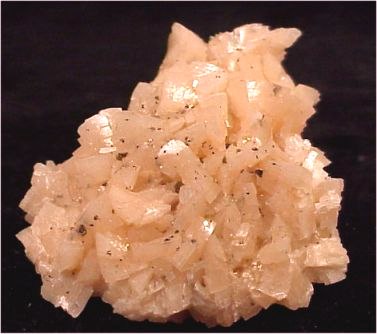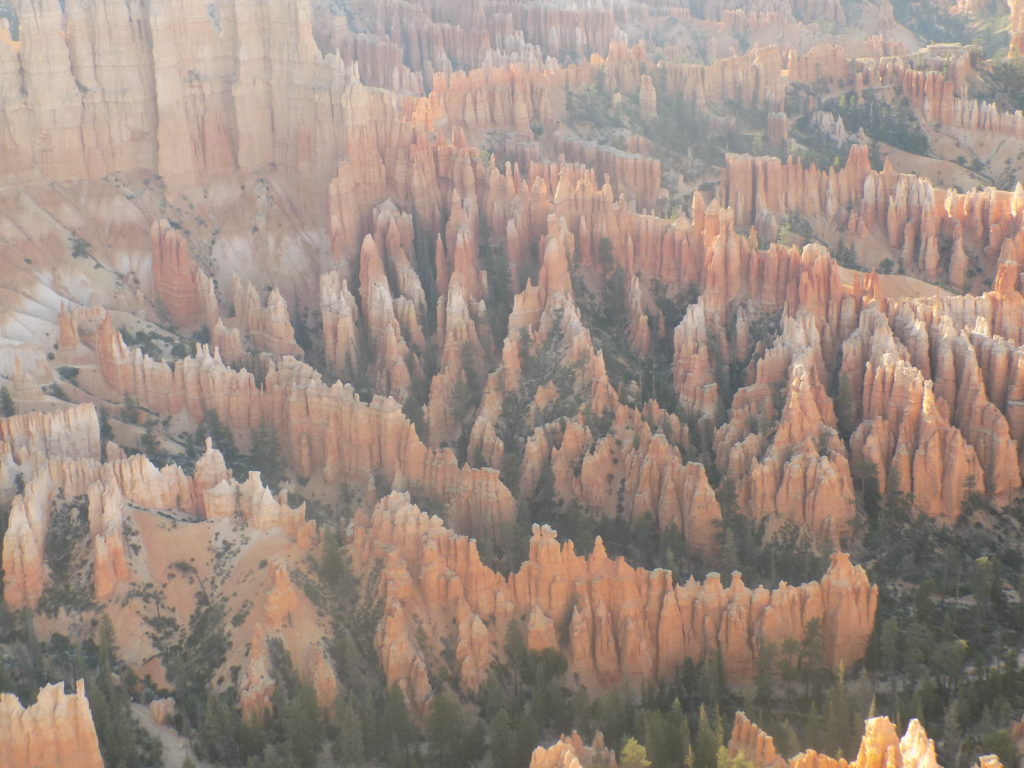No voodoo in a hoodoo.
What I’m about to write concerns the composition of the rocks you see when you look at the hoodoos in Bryce. First, you have to know a little about the Claron Formation.
The Claron Formation is comprised of layers of rock laid down during the Eocene epoch early in the Cenozoic Era during the pause between the two periods of uplift previously noted. During this time, lakes and rivers formed and periodic but extensive floods from those bodies inundated large areas and spread mud, cobbles, and fine silt over the plains. The iron in the mud and silt oxidized over time which then turned the soil into hematite, giving it a distinctive pink and red hue that is now the lower part of the Claron Formation that’s called the Pink Unit. The upper part, usually called the White Unit, mostly consists of white clastic and microcrystalline limestone which was created by the layering of siltstone on top of limestone that was deposited by the ancient lakes.
The main component of the Pink Unit of the Claron Formation is limestone which is relatively soft and easily eroded. Chemically, limestone is calcium carbonate. This means it’s a molecule containing an atom of calcium, an atom of carbon and three atoms of oxygen (or, as a chemist would write it, CaCO3). When rain falls it can alter the chemical composition just enough to form a weak solution of carbonic acid. (This reaction is akin to the one that forms a Karst that I described while recounting my visit to Slovenia last year.) Keep this in mind because you’ll need this information shortly.
But hoodoos aren’t entirely made from limestone. In places, layers of mudstone, conglomerate, and siltstone interrupt the limestone horizontally. These layers are more resistant to attack by carbonic acid and they can therefore act as protective capstones on the hoodoos. In fact, a type of magnesium-rich limestone called dolomite caps many of the more durable Bryce hoodoos. Dolomite dissolves relatively slowly and consequently protects the weaker limestone underneath.
(Keep in mind, I’m talking about dolomite

the mineral and not Dolemite

the movie.)
How do you (hoo)doo?
Now that we have an idea of the stuff that hoodoos (though not dreams) are made of, let’s take a closer look at some of the various erosive processes that shape them. You see, hoodoos erode in several different ways.
A few paragraphs ago, I suggested you keep in mind the reaction that occurs in limestone when rain falls. That is, the mixing of water with calcium carbonate to form a weak solution of carbonic acid. Chemically, the Claron formation limestone is no different from the Karst limestone so the carbonic acid slowly dissolves the limestone in a process called chemical weathering. This erosive path then rounds the edges of hoodoos thereby giving them their lumpy and bulging profiles.
But that’s not all that’s happening that’s shaping the hoodoos of Bryce Canyon. Although Bryce is at about the same latitude as Richmond, VA (37.5° north), it’s between 7,600 and 9,000 feet in altitude. Lower air pressure (making the atmosphere expand and thus lose heat because of the energy it’s using to expand) creates cold nights – especially in winter. The altitude also means that the sun’s ultraviolet rays are more intense (because there’s less atmosphere to filter them – which is also why you can sunburn more easily at high altitudes).
Snow falls in the winter. On a sunny day, the sun’s UV rays will melt some of that snow regardless of the air temperature. Water from the melting snow seeps into the cracks and joints then it refreezes at night. This creates a process called frost weathering.
But before I get to that discussion, let’s take a picture break. This formation is called Silent City. For a longer photo break, you can visit this album.
Back to the discussion at hand. Actually, frost weathering isn’t a thing in and of itself. It’s a blanket term covering a variety of processes such as frost shattering, frost wedging, and cryofracturing. Most erosion takes place gradually – that’s why creating these canyons requires millions of years. And the process is inexorable. Even the dammed and flow regulated Colorado River continues to erode the Grand Canyon but these man-made changes have slowed the annual pace to one about equal to the thickness of a single sheet of paper (about 2/1000 of an inch or .05mm). One of the aspects of frost weathering that makes it so interesting is that its effects can sometimes show up in minutes while under other circumstances the effects require years. It operates spatially in much the same way. It can be limited to dislodging a single grain of rock or, just as easily, a large boulder.
I described the first step of frost weathering above. Melting snow seeps into the cracks and joints of the rock formation. The sun sets. The temperature drops and the water refreezes. When water freezes, its volume increases by nine percent and under certain sets of circumstances, this expansion then displaces or fractures the rock in which it’s trapped. Then, the force of the expanding ice helps to erode the soft limestone rock such as that found in the Claron Formation. Over the course of a typical winter at Bryce, more than 200 of these freeze/thaw cycles occur and over time, the hoodoos change. It’s said that one some winter nights you can, in fact, hear the hoodoos going
